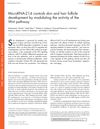Search
forLearn
2 / 2 resultslearn Osteopontin
signaling protein that, when suppressed, may grow hair by reducing inflammation and stem cell loss
Research
5 / 1000+ resultsresearch Orchestrated Role of MicroRNAs in Skin Development and Regeneration
MicroRNAs are crucial for skin development, regeneration, and disease treatment.

research MicroRNA-214 Controls Skin and Hair Follicle Development by Modulating the Activity of the Wnt Pathway
MicroRNA-214 is important for skin and hair growth because it affects the Wnt pathway.

research The Functions of Ocu-miR-205 in Regulating Hair Follicle Development in Rex Rabbits
Ocu-miR-205 affects hair density in Rex rabbits by influencing cell processes and signaling pathways.
research Identification of Potential miRNA–mRNA Regulatory Network Associated with Growth and Development of Hair Follicles in Forest Musk Deer
The research found genes and miRNAs that may control hair growth in Forest Musk Deer.

research Stem Cell Quiescence Acts as a Tumor Suppressor in Squamous Tumors
Inactive hair follicle stem cells help prevent skin cancer.
Community Join
5 / 29 resultscommunity Does melatonin dissolve in isopropyl alcohol
The conversation discusses making a topical melatonin solution for hair loss treatment, questioning if isopropyl alcohol can dissolve melatonin. Melatonin is soluble in lipids and alcohol, but it's unstable and should be mixed fresh regularly; it may help hair growth by affecting certain cellular signaling pathways and has anti-androgenic effects.
community New Research- Creatine Increasing Scalp DHT Without Corresponding Serum DHT Increase
Creatine may increase scalp DHT without affecting serum DHT, potentially speeding up male pattern baldness (MPB) for those genetically prone. Treatments mentioned include Minoxidil, finasteride, and RU58841.

community Compressed part of research of theory of androgenic/anabolitic balance. AGA h-responders analytic. Theory of physio-metabolitic method of anti AGA treatment
The treatment for androgenetic alopecia involves using finasteride and minoxidil with intense exercise and cold exposure to boost metabolism and reduce androgenic effects, potentially leading to hair regrowth. This approach may activate biological pathways for improved hair and overall health.
community The Real Cause Of Androgenetic Alopecia
Androgenetic alopecia is caused by DHT affecting hair growth. Finasteride and minoxidil are used to manage hair loss by blocking DHT and promoting hair growth.
community Currently crushing 3 (5mg) tablets of fin into my topical min. Anyone do the same? If so how much do you add.
The conversation discusses using crushed finasteride tablets mixed with topical minoxidil for hair loss treatment. Users share their experiences and opinions on the effectiveness and proper concentration of this method.